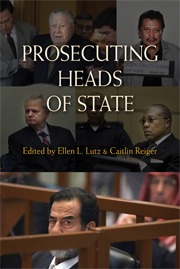Book contents
- Frontmatter
- Contents
- List of Contributors
- About the International Center for Transitional Justice
- Foreword
- Preface
- 1 Introduction
- 2 Prosecutions of Heads of State in Europe
- 3 Prosecutions of Heads of State in Latin America
- 4 The Multiple Prosecutions of Augusto Pinochet
- 5 A Leader Takes Flight: The Indictment of Alberto Fujimori
- 6 Charm and Punishment: How the Philippines' Leading Man Became Its Most Famous Prisoner
- 7 Shifting Legitimacy: The Trials of Frederick Chiluba
- 8 A Justice “Trickle-Down”: Rwanda's First Postgenocide President on Trial
- 9 Justice Squandered? The Trial of Slobodan Milošević
- 10 A Big Man in a Small Cell: Charles Taylor and the Special Court for Sierra Leone
- 11 Political Pedagogy, Baghdad Style: The Dujail Trial of Saddam Hussein
- 12 Conclusion
- APPENDIX: List of Prosecutions of Heads of State or Government since 1990
- Selected Bibliography
- Index
4 - The Multiple Prosecutions of Augusto Pinochet
Published online by Cambridge University Press: 06 August 2009
- Frontmatter
- Contents
- List of Contributors
- About the International Center for Transitional Justice
- Foreword
- Preface
- 1 Introduction
- 2 Prosecutions of Heads of State in Europe
- 3 Prosecutions of Heads of State in Latin America
- 4 The Multiple Prosecutions of Augusto Pinochet
- 5 A Leader Takes Flight: The Indictment of Alberto Fujimori
- 6 Charm and Punishment: How the Philippines' Leading Man Became Its Most Famous Prisoner
- 7 Shifting Legitimacy: The Trials of Frederick Chiluba
- 8 A Justice “Trickle-Down”: Rwanda's First Postgenocide President on Trial
- 9 Justice Squandered? The Trial of Slobodan Milošević
- 10 A Big Man in a Small Cell: Charles Taylor and the Special Court for Sierra Leone
- 11 Political Pedagogy, Baghdad Style: The Dujail Trial of Saddam Hussein
- 12 Conclusion
- APPENDIX: List of Prosecutions of Heads of State or Government since 1990
- Selected Bibliography
- Index
Summary
General Augusto Pinochet of Chile thought it would be a short trip. His plan had been to shop a bit in Paris, then go look into some arms sales in the United Kingdom, one of his favorite countries. He also needed back surgery, and surgeons at a prestigious private London clinic had agreed to perform it. He thought he would soon be back in Chile, the country he had led for seventeen years as dictator and later as appointed president, and where he was now an appointed senator-for-life. He turned out to be wrong. It would be 502 days before he would see Chile again; when he did, it would be a changed country, and he would have a changed position in it. Pinochet was the poster child for the dictatorships that swept across Latin America during the 1970s. On September 11, 1973, he overthrew Chile's elected president, Salvador Allende, and installed himself at the head of a military junta. Over the next months and years, former government officials, leaders of unions or student groups, or anyone suspected of antiregime political activity would be rounded up, imprisoned, tortured, and killed. In more than one thousand cases, the bodies were never found, and the families never knew the fate of their loved ones. Congress was dissolved, unions and political parties banned, and the courts tamed. In 1978, the military passed a law giving itself amnesty for the crimes committed up until that time.
- Type
- Chapter
- Information
- Prosecuting Heads of State , pp. 77 - 94Publisher: Cambridge University PressPrint publication year: 2009
- 3
- Cited by



